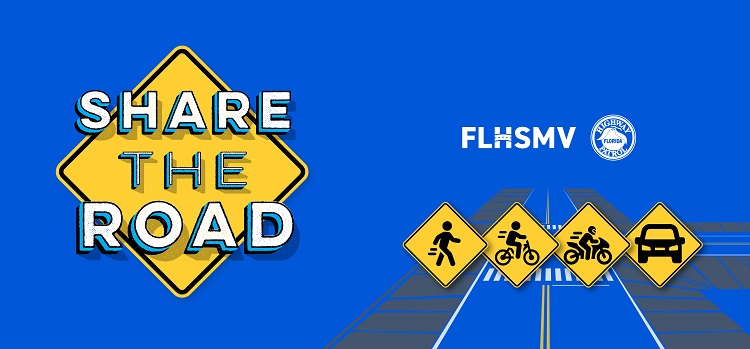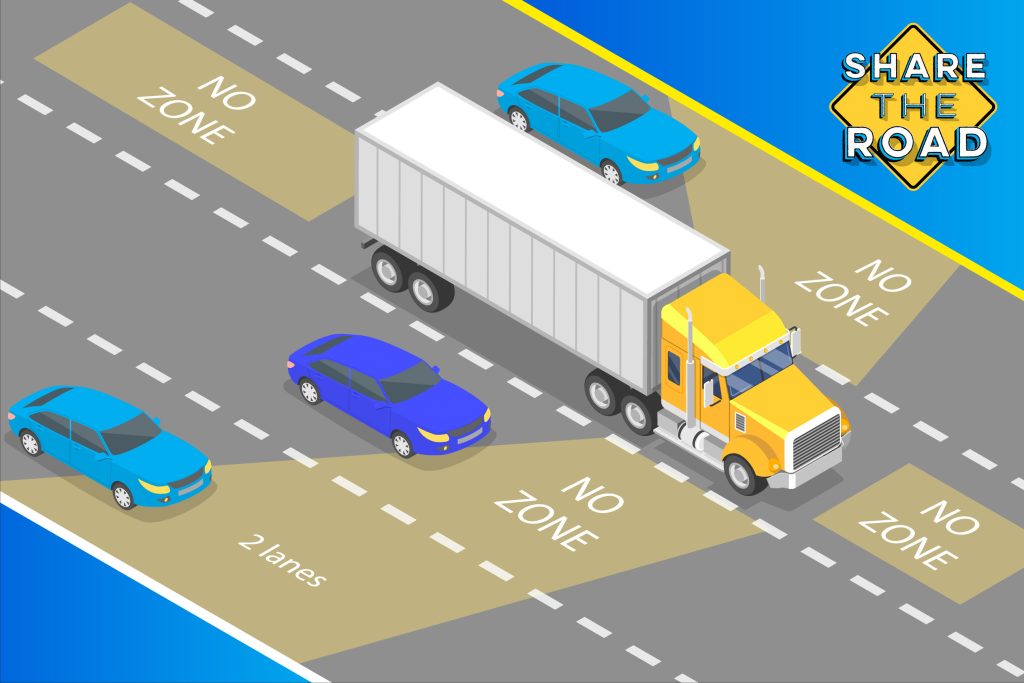When Sharing the Road, We Share Responsibility

~ All road users must work together to foster safety on Florida’s roadways. ~
TALLAHASSEE, Fla. – The Florida Department of Highway Safety and Motor Vehicles (FLHSMV), its division of the Florida Highway Patrol (FHP) and its public safety partners want to remind all who travel Florida’s roadways and interstate systems that sharing the road safely is a collective effort. From pedestrians to commercial motor vehicle drivers, and everyone in between, each road user has a responsibility to promote a safe traveling environment for all.
“Many different road users travel across Florida daily, yet they all share the same goal: to arrive to their destination safely,” said FLHSMV Executive Director Dave Kerner. “It is critical for motorists and non-motorists alike to remain aware of their surroundings and operate on the roadway with the utmost caution and care for others. Sharing the road safely prevents crashes and preserves life.”
“Drivers accept an important responsibility each time they get behind the wheel,” said Florida Highway Patrol Colonel Gary Howze. “While vulnerable road users such as pedestrians and bicyclists must be extra attentive, drivers must be alert when sharing the road with them. Exercising courtesy, eliminating distractions, and following the rules of the road should be top priorities for all when it comes to traveling Florida’s roadways and interstate systems.”
There are many individuals who qualify as a vulnerable road user under Florida law, including pedestrians, motorcyclists and bicyclists. When traveling alongside vulnerable road users, all other motorists must proceed carefully to keep them out of harm’s way.

When approaching intersections, changing lanes, or opening their vehicle’s door, motorists must exercise caution to avoid endangering bicyclists. Additionally, motorists must yield to bicyclists in bike lanes and maintain a minimum of three feet of clearance when passing or driving alongside a bicyclist. In 2024, over 200 bicyclists suffered fatal injuries and over 950 suffered serious injuries during crashes.
While motorists must do their part to protect bicyclists, bicyclists also have duties pertaining to staying safe and preventing crashes. In Florida, a bicycle is legally defined as a vehicle and has the same rights, privileges and responsibilities. This includes obeying all traffic controls and signals while operating on public roadways and utilizing bike lanes if unable to travel at the same speed of traffic. Between sunset and sunrise, bicyclists must have a white light visible from 500 feet on the bicycle’s front, a red reflector and a red light visible from 600 feet on the back. All bicyclists aged 16 and under are required to wear a helmet, yet riders of all ages are encouraged to wear one, too.

Among all road users, pedestrians have the highest fatality rate in Florida as they interact with motorists, bicyclists, motorcyclists and commercial motor vehicle drivers while using sidewalks, crosswalks and intersections. In 2024, over 700 pedestrians suffered fatal injuries and over 1,400 suffered serious injuries during crashes.
As a pedestrian, it is important to know where to use the roadway. If sidewalks aren’t available, pedestrians should walk on the side of the roadway facing oncoming traffic and as far from the traffic as possible. Whenever able, pedestrians should cross streets at crosswalks or intersections, where drivers expect pedestrians, and look for vehicles in all directions, including those turning. If neither are available, pedestrians should locate a well-lit area with the best view of traffic and wait for a gap that allows enough time to cross safely.
Even the safest of drivers might struggle to see pedestrians, and it is imperative, just like bicyclists, for pedestrians to stay seen. During the day, pedestrians should wear bright clothing and in dark conditions, pedestrians should wear reflective materials and/or use a flashlight. Pedestrians should never assume a driver sees them and should make eye contact with drivers as they approach to ensure they are seen.

When considering Florida’s unmatched beauty, it’s no secret it is home to multiple motorcycle events like Daytona Bike Week and many others. With many motorcyclists traveling throughout Florida every year, other motorists must keep their eyes peeled to ensure those motorcyclists can ride again tomorrow.
Motorcyclists need plenty of space to operate as motorcycles can stop more quickly than other vehicles. Additionally, a motorcycle is entitled to an entire lane of traffic and other motorists should not attempt to share a lane with a motorcycle and motorcyclists should not lane split, likewise. Motorists must carefully enter an intersection or change lanes, as motorcycles can be hard to spot. In 2024, over 600 motorcyclists suffered fatal injuries and over 2,000 suffered serious injuries during crashes.
Florida law requires motorcyclists to wear a U.S. Department of Transportation-compliant helmet and protective eye gear when riding. Only motorcyclists over 21 may operate or ride without headgear if they have proper insurance coverage, however, wearing a helmet is highly encouraged regardless.
FLHSMV aims to best equip Florida motorcyclists for responsible rides through training programs, courses and endorsements which provide riders with fundamental education to stay safe and avoid crashes while riding in Florida.

Commercial motor vehicle (CMV) drivers play an essential role in Florida’s economy, and it is important for other motorists to be aware of the needs CMV drivers have as it relates to time and space. CMVs are larger and heavier than the average vehicle and need more space to operate, time to stop and room to execute turns. In 2024, nearly 70 CMV drivers (and passengers) suffered fatal injuries and 200 suffered serious injuries during crashes. Of all the crashes in 2024 involving a CMV, all other motorists, passengers, bicyclists and pedestrians, collectively, suffered almost five times as many fatalities and over four times as many serious injuries.

CMVs have large blind spots in the front, back and on both sides referred to as the “No Zone.” When operating around a CMV or other large vehicle such as a bus, other motorists should refrain from lingering in the “No Zone.” When passing a CMV, motorists should pass on the left for maximum visibility and reenter the lane with plenty of space in front of the CMV after passing.
FHP and its Commercial Vehicle Enforcement unit work alongside CMV drivers to ensure they are following safe operating practices and that their vehicles are safely maintained as they travel across Florida.
“As people continue to move to and visit our great state, it’s critical that we all respect and are patient with one another on the road,” said Alix Miller, President and CEO of Florida Trucking Association. “Understanding how commercial motor vehicles maneuver and their limitations compared to other vehicles can ensure we all make it home safely to our loved ones.”
“FDOT takes great care to create a robust transportation system and build safe infrastructure with the needs of all travelers in mind. As we continue to ensure everyone’s safety through our planning and engineering, we’re encouraging all Floridians to do their part to make safe decisions no matter the travel choice,” said Florida Department of Transportation Secretary Jared W. Perdue, P.E. “As residents and visitors alike continue to get out and enjoy our state, let’s work together to ensure that everyone gets home safely.”
“Florida’s roads carry millions of residents and visitors every day, and it’s up to each of us to ensure every journey ends safely,” said Florida Sheriffs Association President and Charlotte County Sheriff Bill Prummell. “The ‘Share the Road’ message is simple: obey the rules, stay alert, and show courtesy to motorcyclists, bicyclists, commercial drivers, pedestrians, and every other vulnerable road user. Remember to also slow down and move over for stopped emergency vehicles, tow trucks, service workers, or disabled vehicles. Safe, attentive driving isn’t just a campaign slogan, it’s a way of life that saves lives.”
FPCA President Charlie Vazquez said, “Being attentive and sharing the road is part of being a good driver. The Florida Police Chiefs Association encourages everyone on the road to practice respect and cooperation, stay attuned to pedestrians, bicyclists, and all types of vehicles while you are on Florida’s roadway. By being considerate and cautious, we make the roads safer for all road users. Join us in making a commitment to safety and respect on the road this May.”
Whether your mode of transportation involves 18 wheels, handlebars or shoelaces that need tying, remember that it is important to eliminate distractions, never drive impaired and exercise patience and kindness as you travel. By abiding by these tips when it comes to sharing the road, you and all other travelers can arrive alive. For more information, visit the Share the Road webpage.

###
The Florida Department of Highway Safety and Motor Vehicles (FLHSMV) provides highway safety and security through excellence in service, education, and enforcement. Learn more on our website.
The Florida Highway Patrol strives to achieve core values of courtesy, service, and protection. It is FHP’s job to help ensure the safety and welfare of millions of Florida’s residents and visitors every day.
To learn more about FHP or how to become one of Florida’s Finest, visit BeATrooper.com.

Dave Kerner, Executive Director